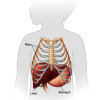
 Dr. Aabha Nagral
Dr. Aabha Nagral
Pediatric Fatty Liver Disease
- Counseling against binge drinking, smoking, use of electronic nicotine delivery device.
- Families of children with NAFLD should be counseled about the risk of second-hand smoking exposure.
- Ensure protection against Hep A and B.
- Lifestyle modifications: Encouraging a balanced and healthy diet, regular moderate to high-intensity physical activity, avoiding sugar-sweetened beverages and limiting screen time.
- Medications: No proven therapy.
- Bariatric surgery can be considered in select patients. Hereditary fructose intolerance, lysosomal acid lipase deficiency, dyslipidemia, citrin deficiency and Wilson disease may present as fatty liver. But they should be seen as a red flag to prevent any future morbidity.

Dr. Aabha Nagral
Dr. Aabha Nagral is a senior consultant at Apollo and Jaslok Hospitals in Mumbai. She also runs her private clinic - Nagral clinic in Prabhadevi area, Mumbai. She is a Gastroenterologist by training from KEM Hospital, Mumbai with specialisation in liver diseases adult and pediatric and liver transplantation from Royal Free Hospital and Kings College Hospital, London UK and Mayo Clinic, USA. She is currently the chairperson of the liver committee of the ZTCC (Zonal transplant co-ordination committee), Mumbai and a liver committee member of the ROTTO-SOTTO. She is a managing trustee of Childrens Liver foundation an NGO working towards creating awareness about liver disorders in children and helping families of affected children financially and through support groups.















Please login to comment on this article